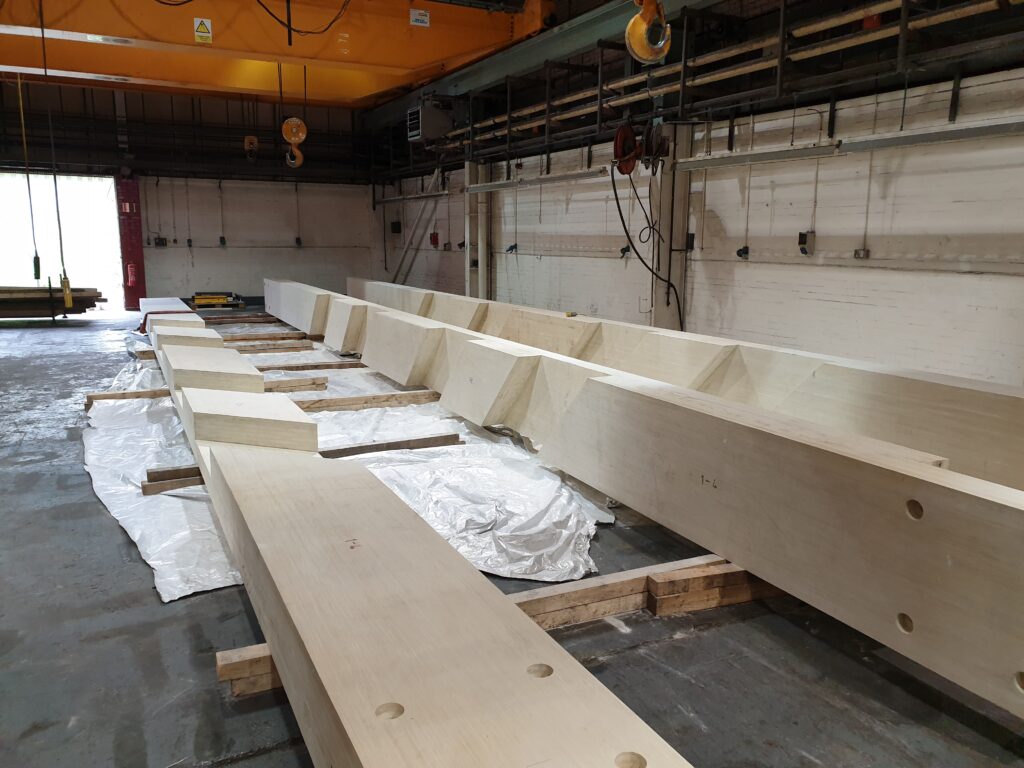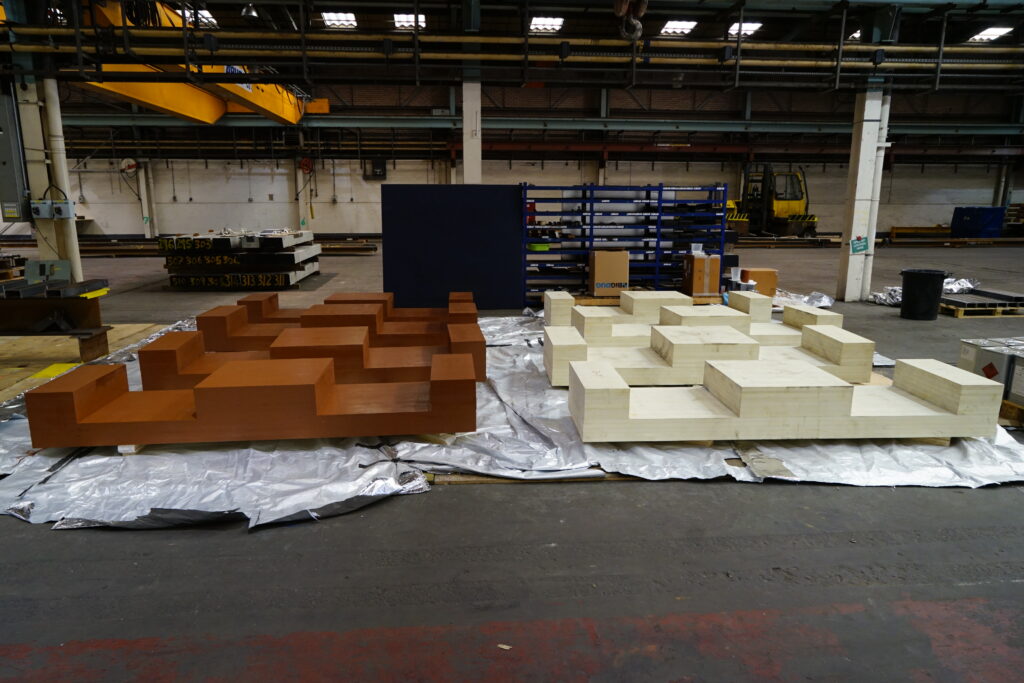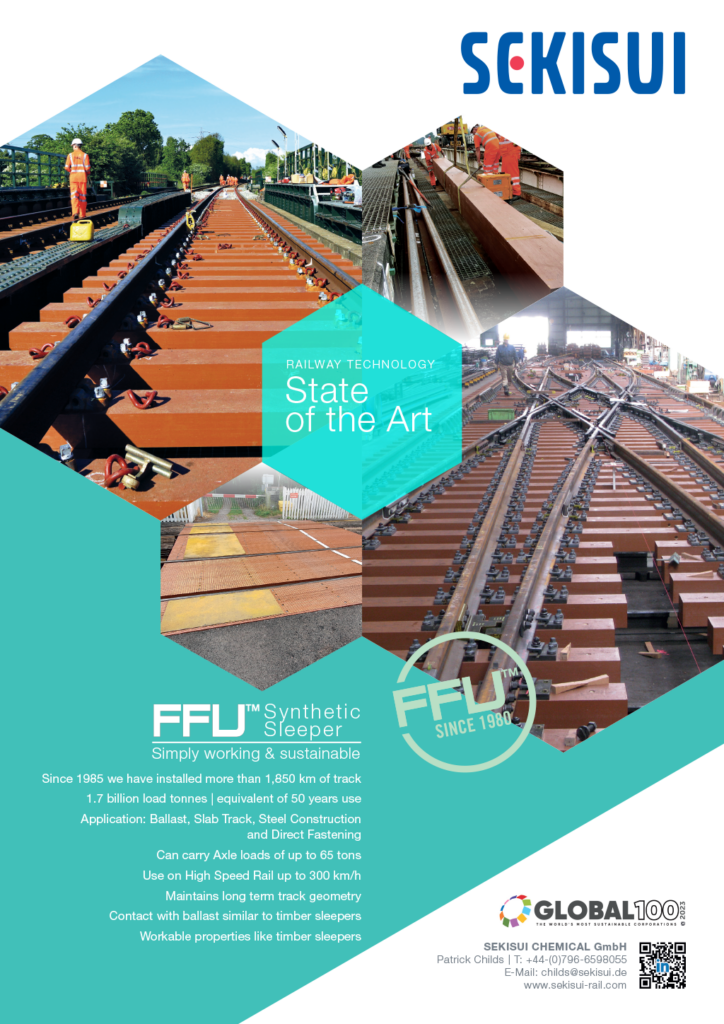Sekisui manufactures synthetic wood baulks made from Fibre-reinforced Foamed Urethane (FFU). Network Rail engineers installed the first FFU baulks and sleepers as replacements for traditional hardwood on military canal bridges in Kent during 2014. The FFU product was first introduced on Japanese Railways in 1980 and early installations are still performing to specification. FFU is now widely used on railway infrastructure in 33 countries to support track on bridges, decking for level crossings, plain line sleepers, and switch and crossing (S&C) bearers.
Newark flat crossing is an example of a unique and large application of FFU technology on Network Rail infrastructure which required the development of the long FFU synthetic bearers forming a lattice track support 16 by 16 metres. Sekisui holds full Network Rail Product Acceptance Certification PA05/07176 for this project which became operational following complete track renewal in August 2019. The FFU was used to replace the traditional hardwood to support the track.
Fabricated to requirement
The FFU baulks can be fabricated and milled to meet site specific geometry requirements including providing holes, notches, pockets, and variable cross level to individual design requirements. Key benefits over hardwood include longevity with over 50 years’ service life. FFU is form retentive, not prone to splitting or absorption of water, and does not rot or deteriorate in sunlight so it contributes significantly to ‘whole life cycle cost reduction’ by reducing track maintenance and renewal interventions. The product does not require maintenance inspectors to complete micro-drilling during service life and is fully recyclable.

Situated just north of Newark Northgate station, the flat crossing is located where the east-west Nottingham – Lincoln line crosses the East Coast Main Line (ECML). It is one of the most complex track structures on the route, with no fewer than 16 crossing noses, and carries 160km/h inter-city trains running north-south and heavy freight traffic on the east-west line.
Prior to the 2019 renewal, the supporting lattice that holds the cast crossings into position was made up from hardwood and typically required replacement every 15 years. The last renewal occurred in 2003. Network Rail found that procuring suitable hardwood timbers of 16 metres for a further renewal proved problematic. This led to the decision to adopt alternative technology which ultimately led to lower whole life costs by reducing track maintenance requirements and track renewal interval.
Thanks to close co-ordination between the various partners, the installation weekend went to plan. After the end of services on 25 August 2019, the old trackwork was removed and the supporting ballast replaced, including the installation of geocells to strengthen the formation.
Whilst FFU has been used in various countries, this project is the first time that something on this scale has been fabricated outside Japan. The new bearers are expected to more than double the life of the lattice layout and reduce maintenance intervals, significantly contributing to a favourable business case. Network Rail engineers are considering how FFU could be utilised in other applications, including plain line sleepers, S&C bearers, and level crossings. Installation of FFU for waybeam bridges has full product approval.
Newark flat crossing
For the Newark flat crossing renewal Sekisui offered to provide 16-metre one-piece beams, matching the existing wooden bearer layout. The FFU baulk material was manufactured in Japan to a maximum length of 8 metres. To produce the required 16-metre bearers, Sekisui partnered with Progress Rail to assemble the beams at a facility near Nottingham. This was the first time that this has been done outside Japan. From Spring 2024, FFU will also be manufactured in a new factory in the Netherlands.
The bearers were constructed from 30mm thick, 8-metres-long layers of FFU; these were manufactured in Japan and shipped to the UK for final assembly. Two densities of FFU – 740 and 1,000 kg/m3 (FFU 74 & FFU 100) – were combined in laminated form to give an increased compressive strength near the surface. Specialists from Sekisui worked with staff from Progress Rail to assemble the bearers. These were combined with the other railway elements including the rails and Cast Manganese Crossings manufactured by Progress Rail to complete the huge crossing lattice assembly, weighing more than 40 tonnes. The design was complex, with the interlocking components designed to ensure that the construction matched the specification.

After eight weeks, the novel FFU bearers were finished, numbered, painted, and assembled into the lattice form in the factory to confirm fit. The crossings were then attached by Progress Rail, drilling into the new material which behaves like hardwood. The trackwork was renewed using CEN56 HP rails instead of the previous 56 kg/m BS113A rails, along with new cast steel crossing inserts. Once everything had been fitted accurately each component was marked and the crossing partially dismantled for transport to site. The various components were taken to Newark by rail at the end of July 2019 and reassembled on a site adjacent to the line ready for installation.
Maintenance comparison after four years
Over four years after the renewal of Newark Flat Crossing utilising FFU, Network Rail Track Maintenance Engineers (TME) in Doncaster report significant reduction in maintenance requirements.
The TMEs gave feedback comparing the same time-period after the 2003 renewal:
2003-2007 hardwood timber renewal – track geometry deterioration, ride quality issues, splitting of timbers, failure of screws, several rail management interventions to cast crossings, including cracking of castings leading to early replacement of ironwork.
2019-2023 FFU renewal – stable track geometry with no ride quality issues reported, no screw failures, no deterioration in the FFU material, reduced rail management intervention and no cracking or premature replacement of cast crossings.
In terms of rail management, since the introduction of FFU, Network Rail’s TMEs have reduced the cyclical inspection and maintenance requirements from four-weekly to eight-weekly. There is now only minimal crossing nose profile grinding required and two small casting weld repairs have been done to date.
Sebastian Smith, route engineer (track) East Coast Route, York, commented that his team viewed the project as “a success, with the FFU seeming to offer a fit and forget characteristic which is very beneficial to a maintainer”. He is delighted with the project, stating: “the decision to install based on whole life cost is proving to be correct”.

Sebastian is looking forward to introducing FFU into Switch and Crossing layouts in the next Control Period, as well as a continued Waybeam Bridge renewal programme on the East Coast Route.
Many thanks to Simon Hunt, track maintenance engineer, Doncaster and Sebastian Smith, route engineer (track) East Coast Route, York for their input to this article.
FFU: a background
Developed in conjunction with Japanese National Railways, FFU synthetic sleepers are made using the pultrusion process. Continuous glass fibres are soaked and mixed with polyurethane, and then hardened at a raised temperature, moulded, pulled, and cut to length. This creates a high-quality material that has the life expectancy of plastic and the weight of natural wood. It can also be worked like natural wood.
First installed in Japan in 1980, and adopted for standard sleepers since 1985, FFU has subsequently been installed on several projects in Europe over the past 20 years, particularly turnouts and bridges. FFU sleepers are currently used on more than 1,950km of track around the world.
Tests of the original 1980 FFU sleepers, undertaken by the Railway Technical Research Institute in 2011, predicted that the sleepers could safely continue in use for another 20 years, giving a total life of around 50 years. FFU sleepers have also been certified by Germany’s Federal Railway Office for use on tracks operating at up to 230km/h and 22.5 tonnes axle load.
Lead image credit: Sekisui


